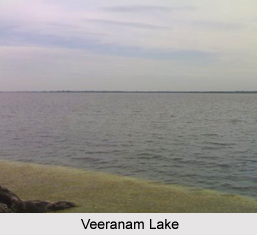 Veeranam Lake is located in the Cuddalore District in Tamil Nadu. It is located 14 km SSW of Chidambaram and is almost 235 km away from the city of Chennai. The Lake acts as a water reservoir and serves as one of the source of water for Chennai. It is a long dam almost 16 kilometres in the north Tamil Nadu.
Veeranam Lake is located in the Cuddalore District in Tamil Nadu. It is located 14 km SSW of Chidambaram and is almost 235 km away from the city of Chennai. The Lake acts as a water reservoir and serves as one of the source of water for Chennai. It is a long dam almost 16 kilometres in the north Tamil Nadu.
History of Veeranam Lake
Veeranam Lake was made during the reign of the Chola dynasty. It was built from 1011 to 1037 AD during the tenth century. The first chapter of the book Ponniyin Selvan has been written on the banks of Veera Narayanar Lake. A detailed explanation has been given about the lake and names of different rivers that flow into the lake have also been mentioned. It is also believed that according to the number of openings the lake had, Ramanujacharya had made a choice about the number of peethas. Veeranam Lake, built by the Chola kings, is the main reservoir to meet the drinking water requirements of Chennai city. The lake draws water from the Cauvery River. It is located at Senthathope which is about 230 km south of Chennai. It has a capacity to store about 1,465 mcft of water.
Developments of Veeranam Lake
Veeram Lake receives water from Kollidam via Vadavar River. It was earlier known as Veeranaaraayanapuram Lake. The project for developing the lake for supply of water was conceived in the year 1967 by the then Chief Minister of Tamil Nadu, C. N. Annadurai. However, it took several years to be completed and finally in the year 2004 it was finished. However, the lake had dried up and it became impossible to get water. Hence, it was decided to dig up 45 deep bore wells in the surrounding area. The water would then be pumped 235 km to Chennai through the pipeline.
The level of water in the Veeranam Lake had reduced to 323 million cubic feet. However, to raise the level 180 mld (million litres a day) was drawn for the supply to the city. Water was also drawn from the Mettur dam through Kollidam and Lower Anicut. This helped in the inflow of water in the Veeranam Lake. During the months of April the lake received sufficient water that sufficed for three months. The heavy rains in the Western Ghats mountain range helps water to store in the Cauvery tributaries Bhavani and Amaravathi. These also supply water to Veeranam Lake.















